In my article in the February 2010 issue of CYC-Online , I looked at the way in which Hermann Gross – an artist-in-residence in a residential child care setting in Scotland – chose to represent children in his art. A particular feature of his work was the way in which he highlighted some of the key dilemmas faced by residential child care staff. A recurrent theme in his paintings is that of masks and masquerades. This theme is potentially disconcerting because it highlights the fact that staff are engaged in the performance of a role, where the meaning of “performance” can take on a broader significance.
What purpose then does the mask perform? Most societies have used masks for various purposes. A mask hides and protects the wearer and in primitive societies it was meant to protect whoever was wearing it from spirits and evil creatures. It also transforms and endows the wearer with the strength and power of what it represents thus making them no longer human. The mask, which is worn over or in front of the face, hides the identity of a person and by its own features, establishes another being. This essential characteristic of hiding and revealing personalities or moods is common to all masks.
Masks are paradoxical because they enable a person to become what he is not; however, this disguise is complicated by the notion of the mask acting as an abstract symbol of duality. Only through recognising and accepting the transformation of a thing from one state to another is it possible to resolve the paradox, and without this ability or desire to reconcile a paradox, our acceptance of change is inconceivable.
Within the field of the visual arts, a shift occurred that fundamentally changed the way man was depicted. In the late 1800s, Impressionist artists placed a great deal of emphasis on the expression of the face in order to convey the meaning within the portrait. However, Cubism, at the beginning of the 20th century, completely reinvented the image of man's face. Instead of soft expressive portraits that sought to capture the essence of humanity through the face, Cubism, influenced by African masks with their distorted proportions, meant that the human face was no longer an indicator of identity. This radical change of artistic perception created a ripple effect that transformed not only modern art but also man's view of himself: whilst totemic images from Africa (Benin) and Oceania (Easter Island) also played an important part in reshaping the artists' interpretation of the human face.
A related theme that runs through Gross’s work was carnival and the figures of Harlequin and Pierrot, traditional figures in the ancient Commedia dell'Arte. Harlequin with his multi-coloured diamond-patterned costume, black trifold Napoleon hat is usually seen as the representation of life, its many-sidedness and riches, whilst lonely and melancholic Pierrot with his sorrowful and whitened face, white broad brimmed conical hat and white loose pyjamas hanging on him like a shroud, symbolises death. Both Harlequin and Pierrot may be depicted masked or unmasked. Harlequin's ability to transform whatever he touched with his magic wand suggests a metaphor for artistic creation through the use of the painter’s brush.
Whilst Gross was a consummate craftsman, many of his paintings convey the impression that they are sketches which are to be worked on later. It may be that he wanted to make the point that no painting can ever truly be finished for the task of the painter is to convey his immediate thoughts and feelings even if that means presenting something that is incomplete. But a more likely explanation is that it reflects the essential character of German Expressionism. This “movement” welcomed any kind of painting that was based on subjective experience and its radical translation into expressive forms and colour arrangements that overcame art’s conventional function of representing or illustrating appearance. This heightened awareness of an inner world led to paintings which were characterised by energetic gestures, distortions of form and orgies of colour.
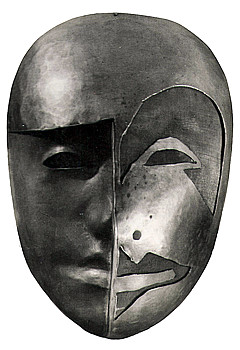
What then is Gross seeking to say with the mask shown in Plate 1? On the right, looking out from the mask, we have a conventional representation of a human face and on the left what appears to be a tribal facemask of some kind. Is Gross drawing a distinction here between our civilised and enlightened nature and our more primitive instincts and feelings which lie hidden? Some weight is lent to such an interpretation by the fact that the left side (sinister) is usually associated with malevolence, gloomy foreboding and evil, whilst the right side (dexter) is linked with benevolence, innocence and moral virtue. By presenting the head in the way he has, Gross may be indicating that humans are necessarily a mixture of both, although attempts to keep our weaknesses concealed meet with varying degrees of success.
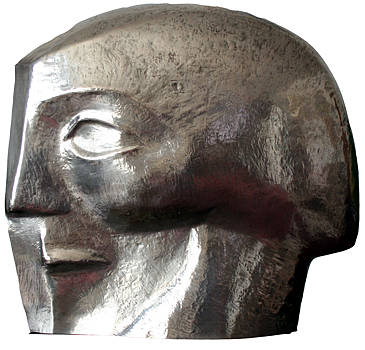
The silver head created by Gross and shown in Plates 2-4 is of particular interest. One quality that this work possesses is playfulness – it is challenging, teasing and puzzling. This playfulness offers both illusions and allusions. One moment the head seems to be one thing, the next moment it is something else. An extraordinary feature of the head is that from the reverse side, the head takes on the appearance of a Cubist painting. The muted palette of bronze, pink, steel blue and grey is strongly reminiscent of certain portraits by Picasso. There can be few examples of a sculpture that mysteriously dissolves into what appears to be a painting.
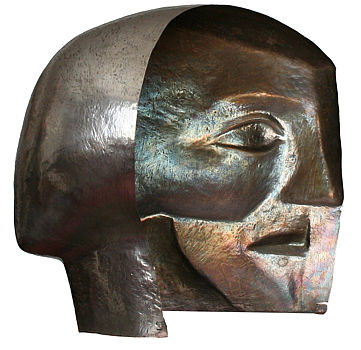
The colours are a natural result of the process of oxidisation. With oxidisation we do not see the destruction of the metal; rather, the oxidisation forms a skin or patina on the metal that acts to protect the underlying surface and actually inhibits further chemical reaction. We know that some contemporary silversmiths deliberately seek to achieve an oxidised effect on their jewellery. What are the aesthetic consequences? Whilst the polished surface quite literally reflects back the external world, the oxidised interior invites the viewer into it. The untreated side provides an authentic face, whilst the polished side provides an artificial face.
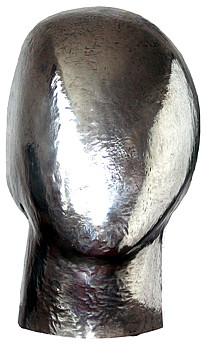
The head is teasing insofar as it presents the viewer with a series of further paradoxes. Whilst the exterior of an object is usually that aspect that gains the viewer’s attention, here it is the interior that appears to possess more character and meaning. What is particularly intriguing is that Gross is inviting us to see behind the mask, something that is rarely done. It is as if a taboo has been broken. To emphasise this feeling of gaining new insights, we are presented with a face in which the eye is dominant and rather like the Eye of Horus – the Ancient Egyptian symbol for indestructibility.
One of the most interesting angles from which to view the head is from the back. From this angle we are presented with a human face stripped of all facial features. Gross would have been aware of the work of Constantin Brancusi, for he was working in Paris at the same time as Gross. He would have known of Brancusi’s minimalist representations of the human face – The Sleeping Muse (1910, Metropolitan Museum of Modern Art). The strongly ovate shape of the face of The Sleeping Muse intentionally suggests an egg – a symbol of birth or new life. In discussing the nature of his work Brancusi coined the striking aphorism that “simplicity is complexity resolved”. So when one moves to a position to view the “rear” of the head, the intrinsic complexity of the head magically resolves into a simple Brancusian ovoid. So in this single artefact – the silver head – we have allusions not only to different artistic genres but also to symbols of considerable power – indestructibility, birth and rebirth. These, in turn, can be interpreted as signs of resurrection and hope – themes that Gross pursued throughout his life.
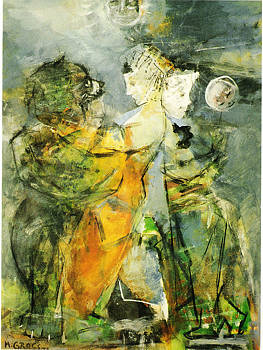
Gross’s preoccupation with the theme of the mask was not confined to his sculpture, for it is very strongly in evidence in his paintings. Let us take the painting shown in Plate 5 which shows a carnival scene. An important feature in any carnival is the masquerade in which people hide their identity behind masks. However, in this particular instance, there is no attempt at disguise either on the woman's part, as she is shown unmasked, or on the part of the person wearing the bear costume, for the woman is looking at the human face below the bear’s head.
The bear costume has been worn in European carnivals since medieval times: whilst the bear itself has been held to symbolise independence, the cycle of life and death and renewal. It should be noted that the bear has also been taken as a symbol of play and the need for people to relax and allow creativity into their lives. There is a paradox here for in the child's world the bear is one of the most common and loved of children's toys, notwithstanding the fact that if confronted in the wild such an animal would pose a real threat to life. Is Gross commenting on the dangers of over-romanticizing reality and presenting to children a misleading and idealized view of the world? Is he arguing that one needs to strike a balance in representing to children the light and dark sides of human existence?

In Plate 6 we have a picture of a young woman playing a harp and behind her a masked Japanese Noh player. Is Gross intimating that Western artistic traditions are impoverished, if they “turn their back” on Eastern traditions? The Noh player looks out of the picture directly at the viewer. It is important to indicate that Noh is a classical Japanese performance which combines elements of dance, drama, music and poetry into one highly aesthetic stage art. It has been enacted in Japan since the 14th century. By tradition, Noh actors and musicians, who are almost always male, never rehearse for performances together. Instead, each actor, musician and choral chanter practises his basic movements, songs and dances independently or under the tutelage of a senior member of the school. Thus, the tempo of a given performance is not set by a single performer or director but established by the interaction of all the performers together. In general, Noh plays are not very dramatic, although they are beautiful, since the text is full of poetical allusions and the dances, though slow, are extremely elegant. It is this very beauty, which makes Noh a living art form. Noh also antedates many developments in contemporary theatre, such as absence of scenery or minimalist stage-sets and the symbolic use of props. The musicians and choirs in Noh plays typically wear a formal montsuki kimono (black and adorned with five family crests), whilst the most commonly used prop is the fan which is carried by all performers regardless of role. The masks worn by Noh players are carved from wood, often cedar, which is then gessoed and painted. Some of the most moving works of sculptural art in Japan are Noh masks.
What is the relevance of this picture to those working in a Camphill community? It would appear that the harpist is performing by herself seemingly oblivious to her surroundings. Noh players, on the other hand, engage in a collective performance in which their individuality is subsumed within that of the group. Is this a commentary on the cult of the individual in Western society with its attendant self-centredness which those in Camphill should reject? Or is it a reminder to care staff that if a community is to achieve its goals, there needs to be not only a collective consciousness but a collective effort. This does not necessitate the subordination of one’s individuality but does require recognition of one’s obligations to those that the community is there to serve – the children and young people with special needs.
Of course these interpretations of Gross’s work are entirely mine. They have no authority as Gross left all his work untitled. So they have as much or as little legitimacy as the interpretations of the next person! In this context it is worth pointing out Stravinsky once observed that music is nothing more than a succession of notes: what one makes of what one hears is up to the listener. And so it is with art. A painting is nothing more than a succession of brush strokes: what one makes of what one sees is up to the viewer. What is not in dispute is that Gross set out to challenge the viewers – in this case the residential care workers living in the care setting of which he was a member “to reflect upon the purpose and value of the collective endeavour in which they were engaged.